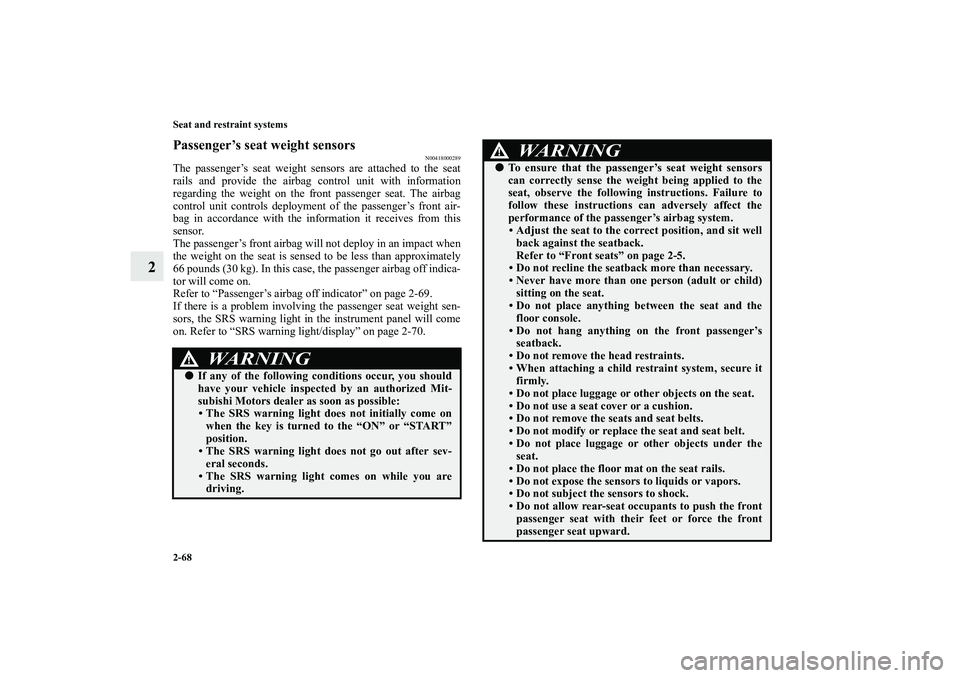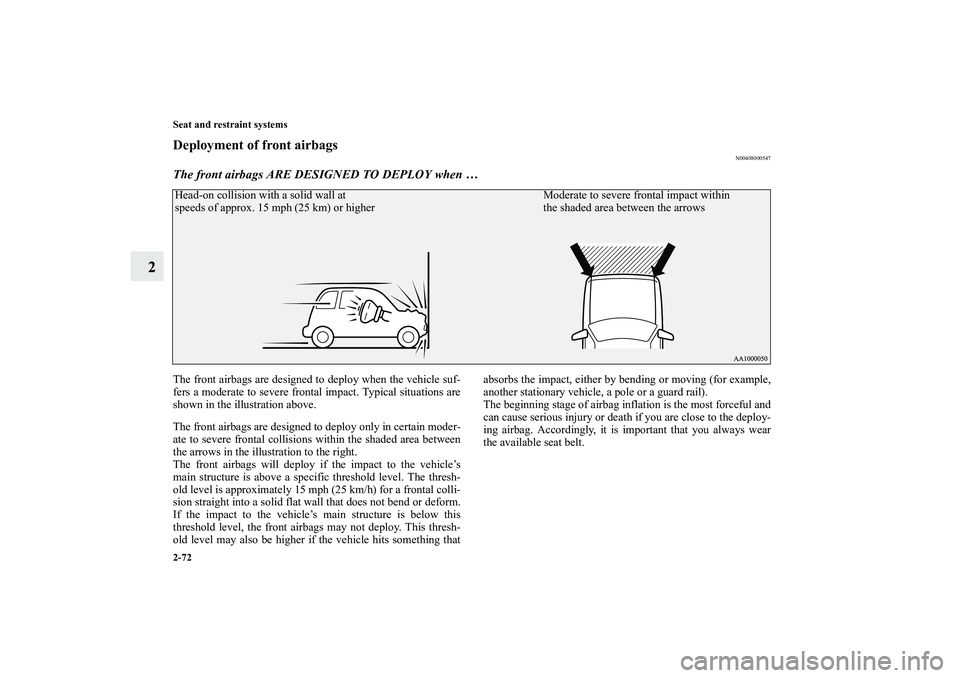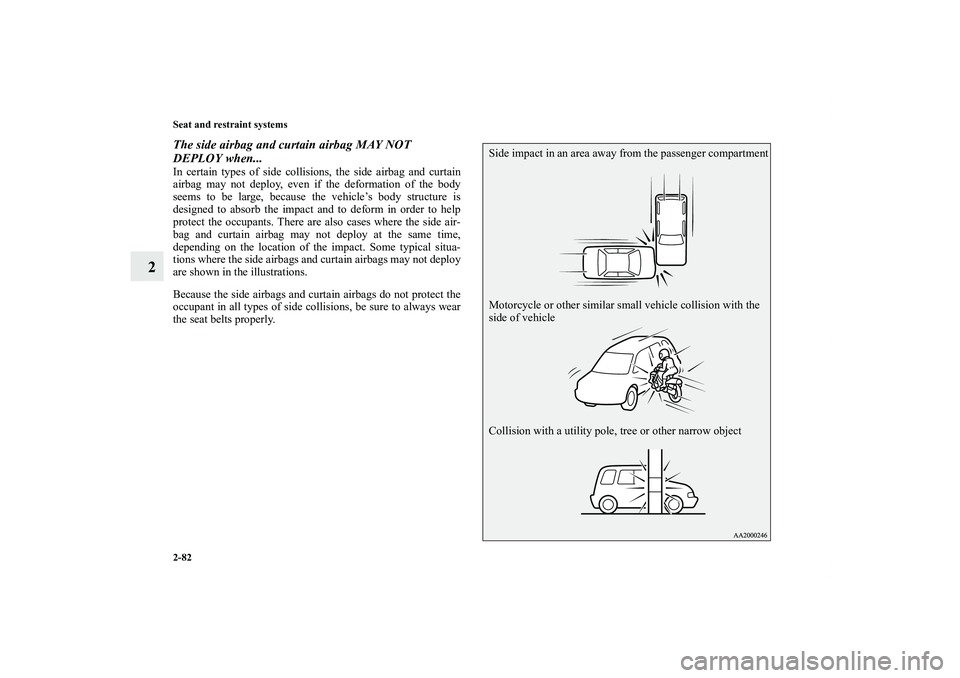Page 95 of 714

2-68 Seat and restraint systems
2
Passenger’s seat weight sensors
N00418000289
The passenger’s seat weight sensors are attached to the seat
rails and provide the airbag control unit with information
regarding the weight on the front passenger seat. The airbag
control unit controls deployment of the passenger’s front air-
bag in accordance with the information it receives from this
sensor.
The passenger’s front airbag will not deploy in an impact when
the weight on the seat is sensed to be less than approximately
66 pounds (30 kg). In this case, the passenger airbag off indica-
tor will come on.
Refer to “Passenger’s airbag off indicator” on page 2-69.
If there is a problem involving the passenger seat weight sen-
sors, the SRS warning light in the instrument panel will come
on. Refer to “SRS warning light/display” on page 2-70.
WA R N I N G
!�If any of the following conditions occur, you should
have your vehicle inspected by an authorized Mit-
subishi Motors dealer as soon as possible:
• The SRS warning light does not initially come on
when the key is turned to the “ON” or “START”
position.
• The SRS warning light does not go out after sev-
eral seconds.
• The SRS warning light comes on while you are
driving.
�To ensure that the passenger’s seat weight sensors
can correctly sense the weight being applied to the
seat, observe the following instructions. Failure to
follow these instructions can adversely affect the
performance of the passenger’s airbag system.
• Adjust the seat to the correct position, and sit well
back against the seatback.
Refer to “Front seats” on page 2-5.
• Do not recline the seatback more than necessary.
• Never have more than one person (adult or child)
sitting on the seat.
• Do not place anything between the seat and the
floor console.
• Do not hang anything on the front passenger’s
seatback.
• Do not remove the head restraints.
• When attaching a child restraint system, secure it
firmly.
• Do not place luggage or other objects on the seat.
• Do not use a seat cover or a cushion.
• Do not remove the seats and seat belts.
• Do not modify or replace the seat and seat belt.
• Do not place luggage or other objects under the
seat.
• Do not place the floor mat on the seat rails.
• Do not expose the sensors to liquids or vapors.
• Do not subject the sensors to shock.
• Do not allow rear-seat occupants to push the front
passenger seat with their feet or force the front
passenger seat upward.WA R N I N G
!
BK0122500US.book 68 ページ 2010年5月12日 水曜日 午前11時11分
Page 98 of 714

Seat and restraint systems
2-71
2
Driver’s and passenger’s front airbag system
N00407900305
The driver’s airbag is located under the padded cover in the
middle of the steering wheel. The front passenger’s airbag is
contained in the instrument panel above the glove compart-
ment. The driver’s airbag and the front passenger’s airbag are
designed to deploy at the same time. However, the front pas-
senger’s airbag does not deploy when the front passenger seat
is not occupied or when the weight sensor in the front passen-
ger seat senses a weight on the seat of less than approximately
66 pounds (30 kg).
WA R N I N G
!�There may be a system error if the warning
light/display appears as indicated. In such cases, an
SRS airbag or a seat belt equipped with pre-ten-
sioner system may not function properly in a colli-
sion. Have your vehicle checked by an authorized
Mitsubishi Motors dealer:
• Even when the ignition switch is in the “ON” posi-
tion, the warning light does not come on or it
remains on a few seconds later
• When warning light comes on while driving
• When warning display appears while driving
Driver
Front passenger
BK0122500US.book 71 ページ 2010年5月12日 水曜日 午前11時11分
Page 99 of 714

2-72 Seat and restraint systems
2
Deployment of front airbags
N00408000547
The front airbags ARE DESIGNED TO DEPLOY when …The front airbags are designed to deploy when the vehicle suf-
fers a moderate to severe frontal impact. Typical situations are
shown in the illustration above.
The front airbags are designed to deploy only in certain moder-
ate to severe frontal collisions within the shaded area between
the arrows in the illustration to the right.
The front airbags will deploy if the impact to the vehicle’s
main structure is above a specific threshold level. The thresh-
old level is approximately 15 mph (25 km/h) for a frontal colli-
sion straight into a solid flat wall that does not bend or deform.
If the impact to the vehicle’s main structure is below this
threshold level, the front airbags may not deploy. This thresh-
old level may also be higher if the vehicle hits something thatabsorbs the impact, either by bending or moving (for example,
another stationary vehicle, a pole or a guard rail).
The beginning stage of airbag inflation is the most forceful and
can cause serious injury or death if you are close to the deploy-
ing airbag. Accordingly, it is important that you always wear
the available seat belt.Head-on collision with a solid wall at
speeds of approx. 15 mph (25 km) or higherModerate to severe frontal impact within
the shaded area between the arrowsBK0122500US.book 72 ページ 2010年5月12日 水曜日 午前11時11分
Page 100 of 714
Seat and restraint systems
2-73
2
The front airbags MAY NOT DEPLOY when …In certain types of front collisions, the front airbags may not
deploy, even if the deformation of the body seems to be large,
because the vehicle’s body structure is designed to absorb the
impact and deform in order to help protect the occupants. Some
typical situations where the front airbags may not deploy are
shown in the illustrations.
Because the front airbags do not protect the occupant in all
types of frontal collisions, be sure to always wear your seat
belts properly.
Collision with a utility pole, tree or other narrow object
Collision where the vehicle slides under the rear body of a
truck
Oblique frontal impact
BK0122500US.book 73 ページ 2010年5月12日 水曜日 午前11時11分
Page 101 of 714
2-74 Seat and restraint systems
2
The front airbags ARE NOT DESIGNED TO DEPLOY
when …The front airbags are not designed to deploy in situations
where they cannot provide protection to the occupants.
Typical situations are shown in the illustration.
Because the front airbags do not protect the occupants in all
types of collisions, be sure to always wear the seat belts prop-
erly.
Rear end collision
Side collision to your vehicle
Vehicle rolls onto its side or roof
BK0122500US.book 74 ページ 2010年5月12日 水曜日 午前11時11分
Page 102 of 714
Seat and restraint systems
2-75
2
The front airbags MAY DEPLOY when …The front airbags may deploy if the underside of the vehicle
suffers a moderate to severe impact (undercarriage impact).
Typical situations are shown in the illustration.
Because the front airbags may deploy in certain types of unex-
pected impacts, as shown in the illustrations, and these unex-
pected impacts can move you out of position, it is important to
always wear the seat belts properly. When worn properly, seat
belts can help maintain your distance from the airbags when
they begin to inflate. The beginning stage of airbag inflation is
the most forceful and can cause serious injury or death if you
are close to the deploying airbag.
Collision with an elevated median/island or curb
Vehicle travels over a deep hole/pothole
Vehicle drives down a steep slope and hits the ground
BK0122500US.book 75 ページ 2010年5月12日 水曜日 午前11時11分
Page 108 of 714
Seat and restraint systems
2-81
2
Deployment of side airbag and curtain airbag
N00408200422
The side airbag and curtain airbag ARE DESIGNED
TO DEPLOY when...The side airbag and curtain airbag are designed to deploy when
the vehicle suffers a moderate to severe side impact to the mid-
dle of the passenger compartment.
The typical situation is shown in the illustration.The seat belts in your vehicle are your primary means of pro-
tection in an accident. The SRS (Supplemental Restraint Sys-
tem) side airbags and curtain airbags are designed to provide
additional protection. Therefore, for your safety and the safety
of all occupants, be sure to always wear your seat belts prop-
erly.Moderate to severe impact to the middle of the vehicle body’s
side structure
When the vehicle detects rollover of the vehicle (Curtain
airbag only)
BK0122500US.book 81 ページ 2010年5月12日 水曜日 午前11時11分
Page 109 of 714

2-82 Seat and restraint systems
2
The side airbag and curtain airbag MAY NOT
DEPLOY when...In certain types of side collisions, the side airbag and curtain
airbag may not deploy, even if the deformation of the body
seems to be large, because the vehicle’s body structure is
designed to absorb the impact and to deform in order to help
protect the occupants. There are also cases where the side air-
bag and curtain airbag may not deploy at the same time,
depending on the location of the impact. Some typical situa-
tions where the side airbags and curtain airbags may not deploy
are shown in the illustrations.
Because the side airbags and curtain airbags do not protect the
occupant in all types of side collisions, be sure to always wear
the seat belts properly.
Side impact in an area away from the passenger compartment
Motorcycle or other similar small vehicle collision with the
side of vehicle
Collision with a utility pole, tree or other narrow object
BK0122500US.book 82 ページ 2010年5月12日 水曜日 午前11時11分